South Asian Modern Masters
SEPTEMBER 2019 - MAY 2020
Featuring formative South Asian Modern Masters from the Hundal Collection, this exhibition includes those who made a critical contribution to the aesthetics of the region from the 1920s through the 1980s. The paintings are to be viewed through a social, political and cultural lens, within the historical context.
PAINTINGS OF INDIA, PAKISTAN, BANGLADESH & SRI LANKA
In the years before Independence and Partition of the Indian subcontinent in 1947, native citizens were galvanized by swaraj , an intense desire for self-rule . Swadeshi , the movement to boycott British goods and replace them by domestic products was a driving force toward the goal of freedom from foreign domination. Gandhi’s acts of civil disobedience in the 1920s and 1930s was intimately linked with the philosophy and methodology of swadeshi. All of these factors played a role, albeit often subtle, in individual and group identities and the expression of art in the subcontinent.
The primary objective of Art schools established by the British in Calcutta (1854), Bombay (1857), Madras (1857), and Lahore (1875) was to resuscitate the native crafts and industrial arts. The eventual introduction of fine art painting to the curriculum in these institutions, played a role in shaping the aesthetics of their students, the future artists of the subcontinent.
This exhibition, featuring formative SOUTH ASIAN MODERN MASTERS from the Hundal Collection of Chicago, includes those who made a critical contribution to the aesthetics of the region from the 1920s through the 1980s. While the paintings suggest a similar trajectory in style, media and subject of the region, personal experience and culture introduce diversity. Paintings in this exhibition are viewed through a social, political and cultural lens within the historical context.
Curated by Professor Marcella Nesom Sirhandi, Ph.D.
EXPLORE THE EXHIBITION
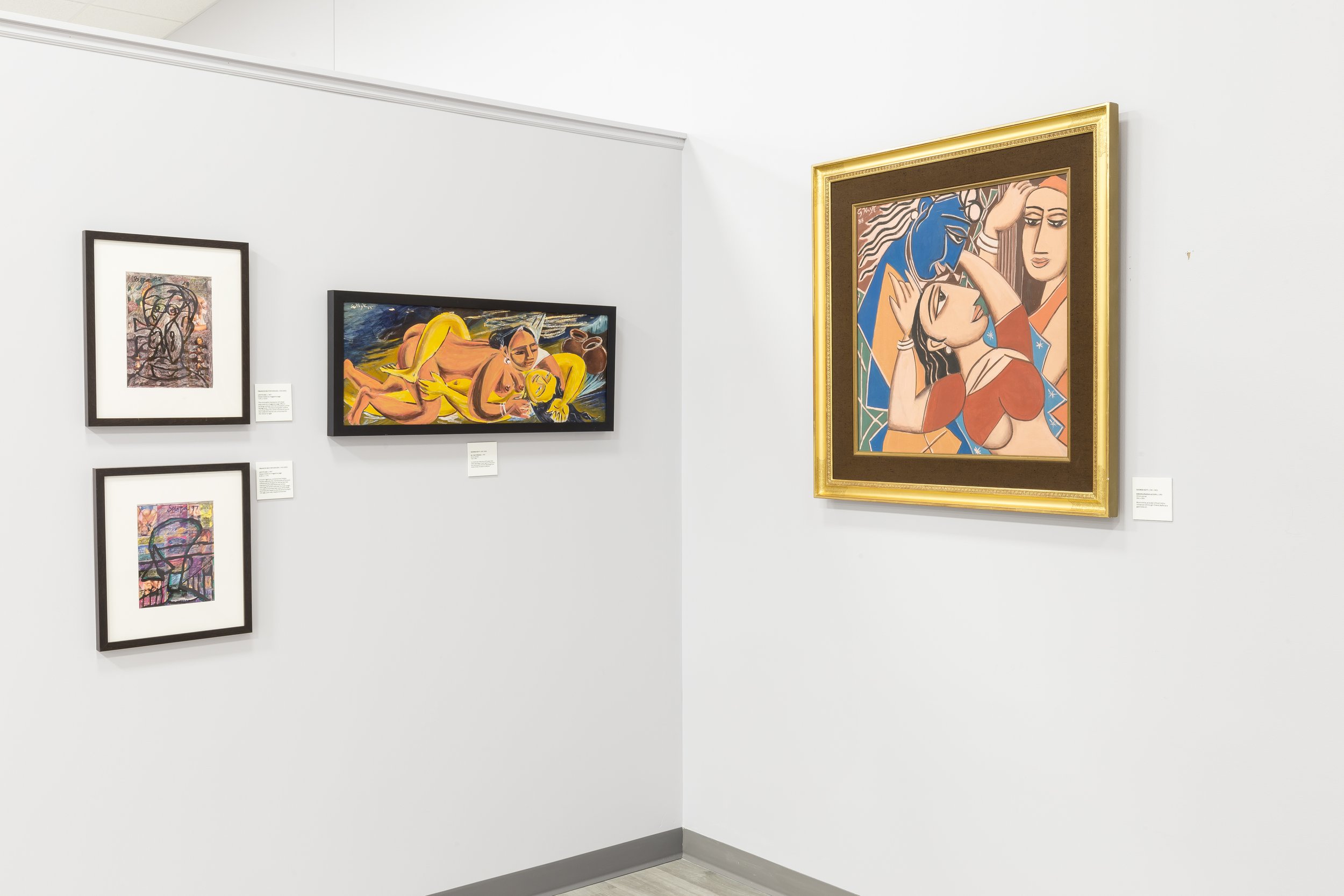
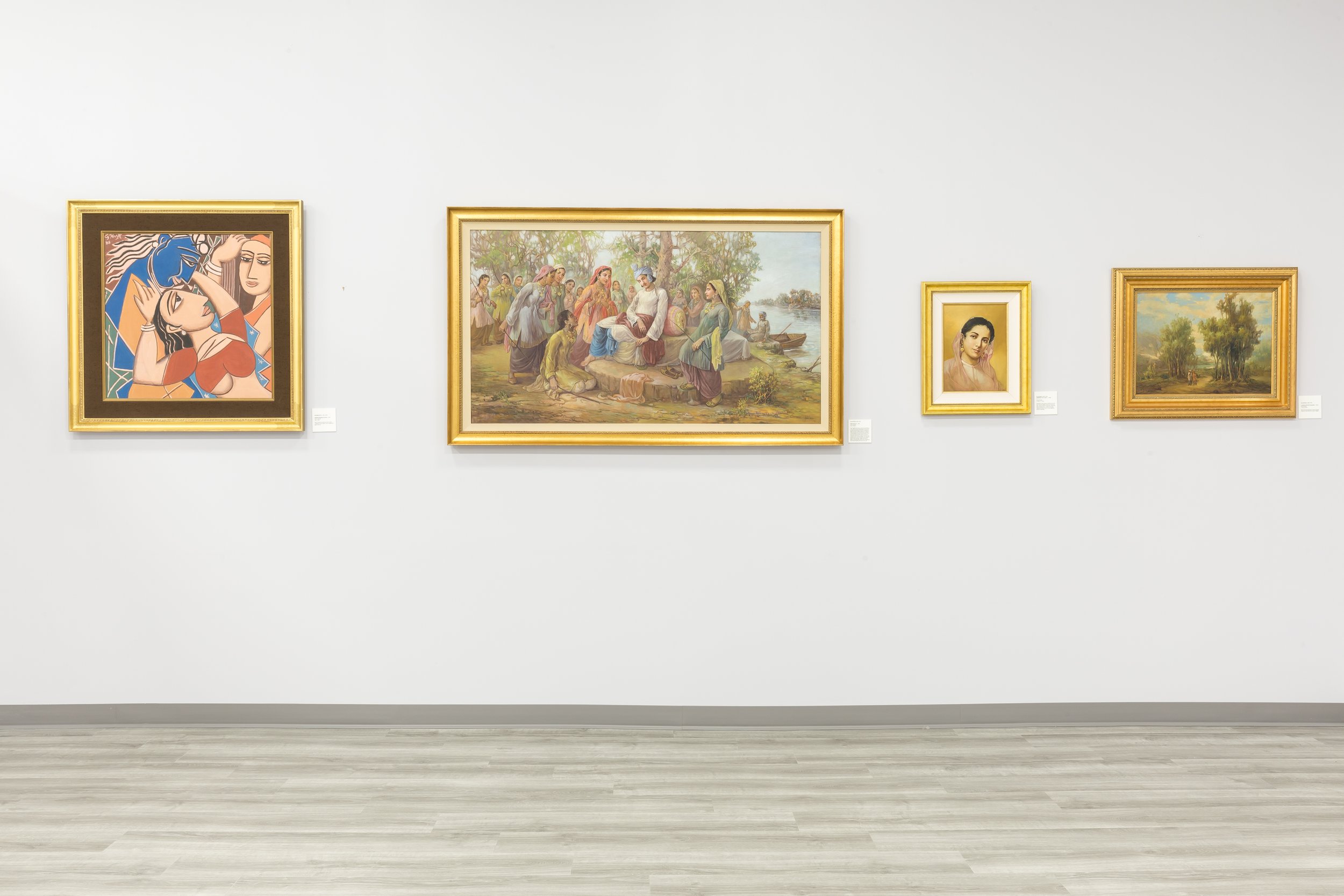
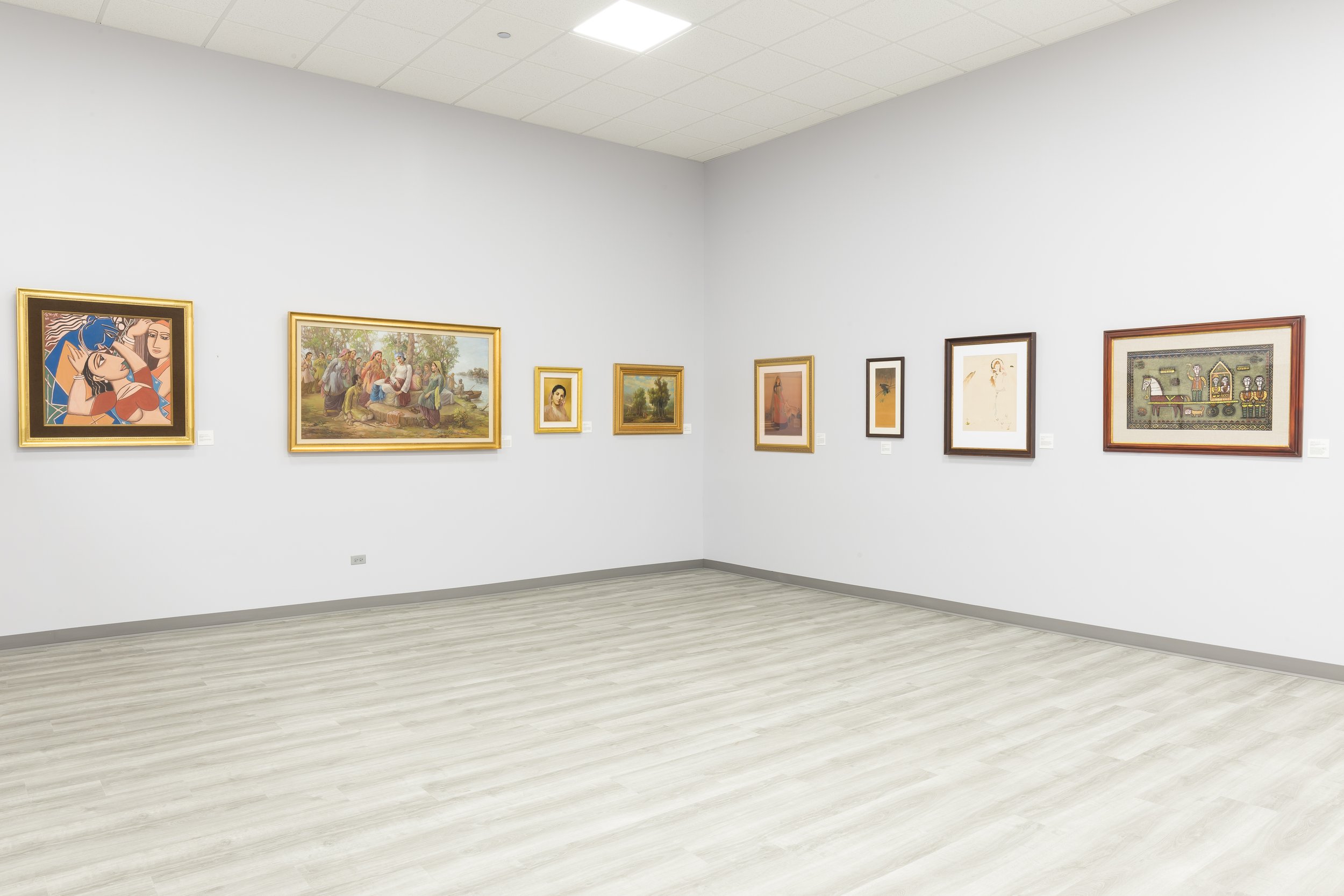
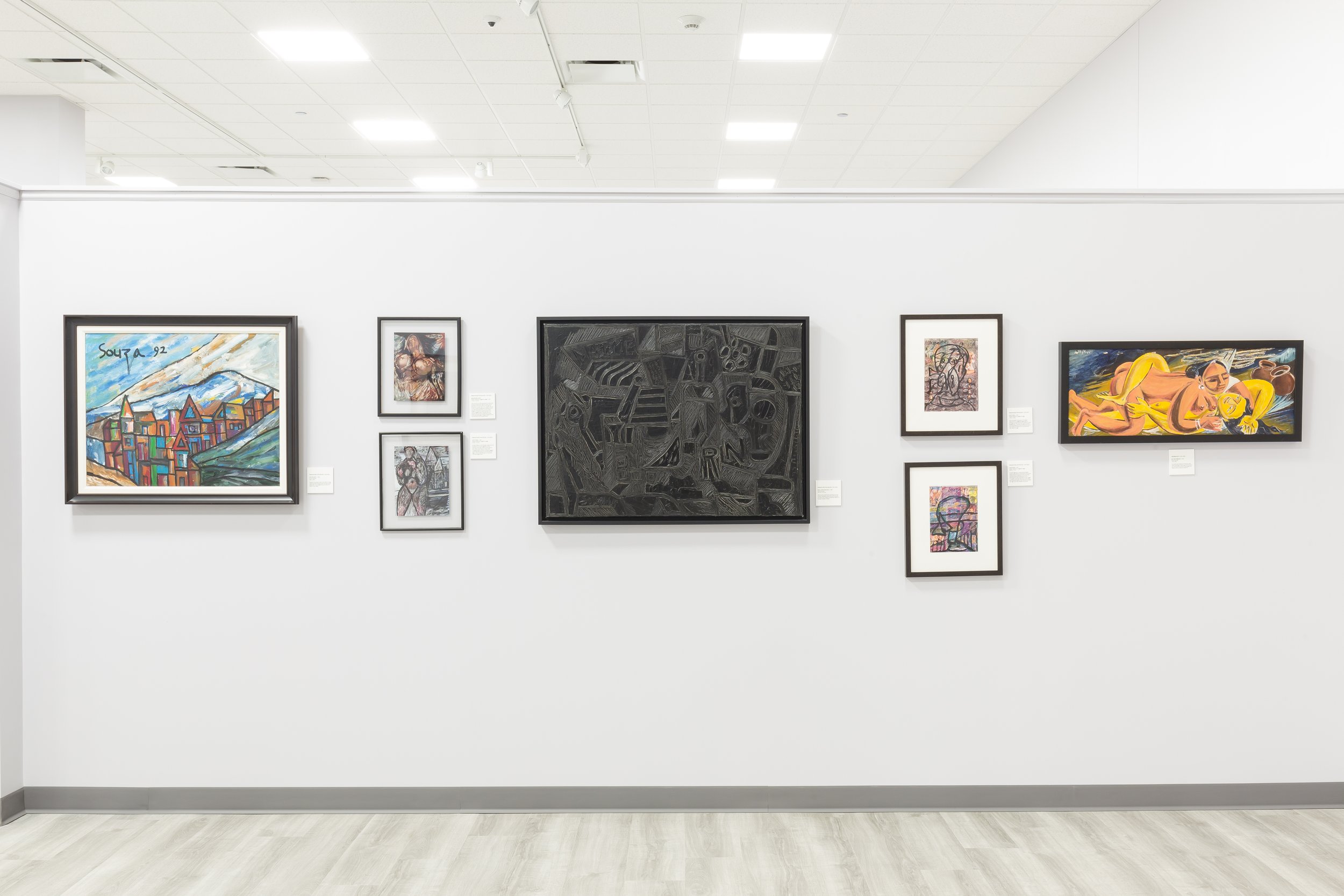
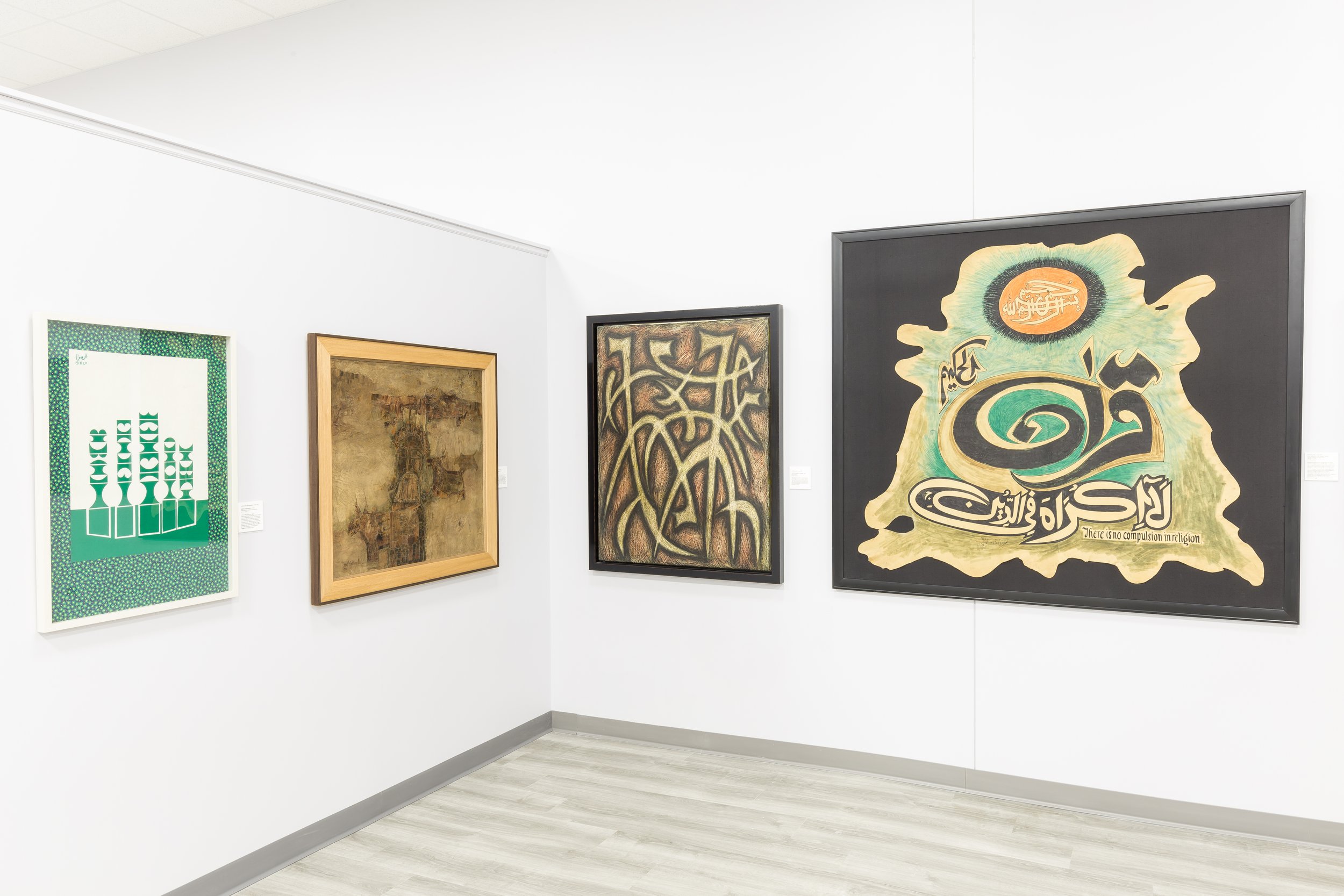
-
REALISM AND ABSTRACTION RENDERED WITHIN A HISTORICAL CONTEXT
The quality and breadth of the Hundal Collection offer paintings with characteristics that contribute to deciphering South Asia’s art history conundrum. Jamini Roy, for example, trained in western painting traditions at the Calcutta College of Art and Industry in the early 1920s, painted realistic portraits and landscapes for a living. Under the influence of swadeshi , Roy abandoned western media and realism and adopted the unique style of Calcutta’s Kalighat artists who sold painted mementos to visitors at the Kali temple. Still not satisfied, he returned to his East Bengal childhood village to learn from folk artists and local craftsmen. Roy’s mature two-dimensional figures held in place by bold solid-colored backgrounds, derived from indigenous sources. His charming Hindu-themed narratives, paired down to essentials, began the modernist trend in India.
Jamini Roy’s modus operandi was a model for other artists across the subcontinent. Before he abandoned realism and returned to the village for inspiration, Jamini Roy was part of the Bengal School movement. The small multi-layered watercolor paintings also referred to as Neo-Bengal School art, spread throughout the subcontinent.
Sultan Ali belonged to an artists’ commune near Chennai (Madras) that sought to create untainted Indian art. In New Delhi Ghulam Rasool Santosh, a Kashmiri Muslim who adopted the surname of his Hindu wife, became a leading member of the Neo-Tantric movement. His many yantra, meditation diagrams, based on yab/yum, produced alluring compositions conceptually divorced from Western themes and motifs. Farther west in what is now Pakistan, Sadequain Ahmad Naqvi painted suras from the Quran on animal skins. His calligraphic oeuvre was part of a popular movement initiated by Anwar Jelal Shemza in the mid 1950s. Ismail Gulgee added color and gold and silver leaf to his large calligraphies, while Rasheed Arshed covered his canvases with unreadable calligraphic strokes that emphasized design over textual communication.
Abanindranath Tagore created the style touted as “the new Indian art” which he taught to students during his tenure as Principal at the Calcutta College of Art and Industry. Across the continent, in Lahore, Abdur Rahman Chughtai altered Tagore’s Bengali watercolor technique to address regional and cultural themes particularly Sufi ideology and Muslim heroes and heroines. He gathered a group of like-minded painters and called it the Lahore School. Not part of Chughtai’s circle, Allah Bux, in the same city during the same era, made a living painting Hindu themes in a variety of media including oil on canvas. His large canvas narratives recorded Punjabi village life and bucolic landscapes. Before Independence, oil on canvas was widely regarded as a Western intrusion so that water-based paints on paper, considered a traditional Eastern medium, was deemed more acceptable. Bux, however, was equally adept at watercolor and many of his pastel landscapes were already abstract in the early 1920s.
Abstraction and non-figuration were not generally accepted until the Progressive Artists Group (PAG) of Mumbai (Bombay) made their mark in 1948. Francis Newton Souza, a Christian from Goa started the group in 1947. His manifesto and figurative paintings are reminiscent of the harsh angles of German Expressionism and Europe’s Brute art. Within a few years Souza, Syed Haider Raza and several other founding members left for Europe and the USA. Maqbool Fida Husain was the most prominent member to remain in India. He painted themes from Hindu mythology, contemporary life often featuring Mother Teresa, as well as sardonic colonial anecdotes. Raza settled in Paris and his lyrical landscapes soon evolved into abstract Tantric inspired yantra configurations. Sohan Qadri, not a member of the PAG but part of an artists’ circle that included Husain, Raza, Swaminathan and Ram Kumar, created striking, subtle monochromatic compositions with punctured geometric designs. The context reflected his spiritual path derived from childhood attachment to a Bengali Tantric yogi and a Sufi who lived near his home. Ram Kumar, a New Delhi painter, started with abstracted cityscapes and moved on to dense non-figurative compositions like the one in this exhibition.
Following the advent of Partition the post-colonial drive to be progressive and to adopt abstraction was universal among South Asian artists. Shakir Ali, who studied with Andre Lhote in France, brought Cubism to Lahore in 1952. That art form spread quickly across Pakistan and was popular in India as well. Sri Lankan painter and poet George Keyt flavored his Cubist-style paintings with characteristics from Hindu and Buddhist architecture.
At the other end of the spectrum, National College of Arts, Lahore educator and principal, Khalid Iqbal revitalized the landscape tradition with on-site paintings. Anna Molka Ahmad, a graduate of London’s Royal College of Art, head of Department of Art at Punjab University Lahore in the years before and after Independence, countered the abstract craze using a pallet knife to render heavy impasto oils on canvas in a modified German Expressionist tradition. Ahmad’s graduates, chairing art departments throughout Pakistan, helped spread variations of the style across the country. Ahmad’s forays into social-political themed paintings caused less drama than those by Abdul Rahim Nagori, who rallied against treatment of women and government corruption. His alphabet series details such events from A to Z.
Bangladeshi artist, Zainul Abedin, brought attention to British colonial mismanagement that caused the devastating Bengal famine in 1942. Abedin’s Ink sketches of starving families were graphic and heart- wrenching. His lyrical watercolors of fishing boats and Bengali landscapes reflected the western art training he received at the Government School of Art in Calcutta. Abedin’s association with the Calcutta Group lent a socialpolitical bent to his art and a modernist proclivity. In 1948 Abedin founded the Dhaka Art Institute where his students like Mohammad Kibria, represented here in the Hundal collection, preferred abstract and non-figurative modes. Like other South Asian artists seeking better exposure, Avinash Chandra took up residence in London in the mid 1950s. In 1962 Chandra was profiled by art historian William C. Archer in a BBC documentary. Multiple awards and distinctions soon followed. Like so many of his compatriots, Chandra travelled on a Rockerfeller fellowship in the 1960s. Pakistani artist, Ahmad Parvez, was lauded in London for his semi-abstract approach emulating that of British artist Alan Davie. He enjoyed great acclaim during his years in Pakistan as well.
Nasreen Mohammadi’s geometric, linear minimalist pencil and black ink compositions are unique in South Asian art. Though seemingly more connected to midcentury Western origins than that of South Asia, Mohammadi remained in India except for the nine years she studied art in London and Paris. The juxtaposition of Mughal miniature painting and modernism was the accomplishment of Pakistani artist Zahoor ul Akhlaq. Bashir Mirza used a background in advertising design to achieve striking socially relevant modernist paintings. The motivations for Lubna Agha’s White Series, that highlighted her momentous rise to fame in Karachi was cause for numerous media coverage. Her art changed dramatically with her 1980 move to California, USA.
Owing to spatial concerns other worthy modernists and mid 20th century painters from South Asia represented in the Hundal Collection have not been featured in this exhibition and those belonging to the later 20th century will be included in future exhibitions.

